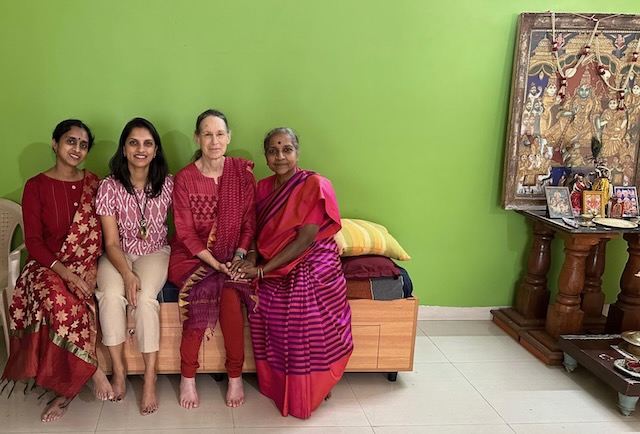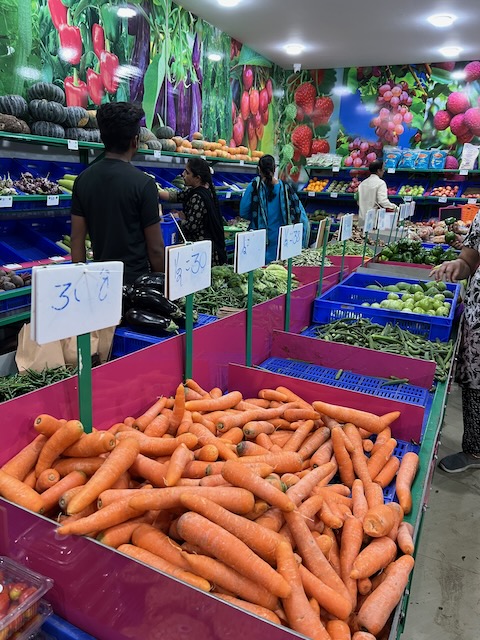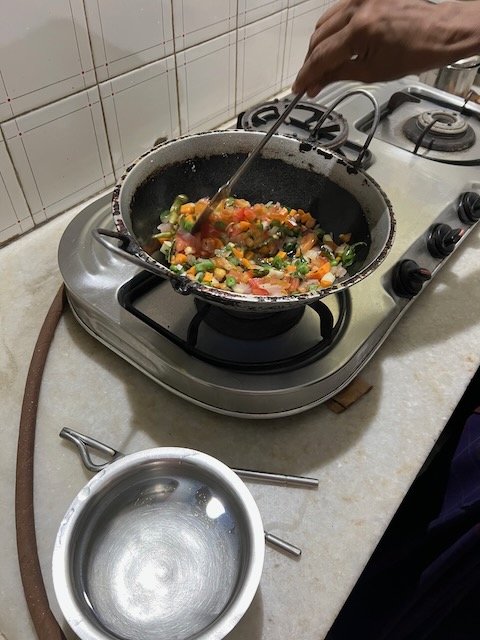India developed and excelled in the art of Billboard Advertising from early on in the 20th century. The intensity of their commercial displays continue although gone are the beautifully hand painted often garish advertisements for Indian films which are now replaced with slick images showcasing cars and electronics, women’s high-end fashion and wedding clothes, and something we do not see in the U.S., advertisements for various brands of Cement: Chettinad Cement, Sagar Cement, Ambad Cement and the list goes on. People when they build a house here specify to their architect not only what they want the building to include but what cement to build it with.
Gayathri’s street in Bangalore is probably a microcosm of what is happening all over urban India. Her house was originally built 30 years ago on completely barren land on the outskirts of Bangalore and I have seen the development of her street over time into a very active market area. Her 3 story home (with her Bharata Natyam dance studio occupying the entire top floor) now is surrounded on all sides by 3 stories of shops. These range from small mom and pop shops selling clothing, household wares, small eateries and fruit juice shops, to large scale enterprises, such as Van Heusen’s, Levi’s, Raymond Suits, Kancheepuram Saris, some very fancy jewelry stores, and even a Fab India (my favorite brand clothing site) nearby. The growth continues unabated, although perhaps slowed locally by the extensive street renovation project throughout the city, replacing and under grounding utility and sewer lines. It is a true obstacle course to even approach the stairs to these local stores with large open pits and piles of mud everywhere following unusual rain for this time of year.
Food is obtained from a combination of traditional small fruit and vegetable markets to new air conditioned shops with pre-packaged produce. I took a walk last night with my friend to look for mangos which have just come into season. Several blocks past the retail stores, walking on the side of the road, skirting the piles of dirt and gravel and the two way traffic which passes pedestrians with an inch or two to spare (there is no sidewalk at all), we look first in an open shop with piles of fruits on tables. There are 2 varieties of mangos there which are not quite ripe. But a few blocks away at an enclosed modern market with refrigerated shelves and organized displays of packaged goods, we find not only 3 varieties of loose mangos but pre-packaged boxes of Alfonso Mangos considered by some “the King of Mangos”. To give you an idea of cost: a very small plastic container of strawberries is about $2.25 (considered a luxury item) and a box of 6 Alphonso mangos, which I buy for the family, cost somewhat more than $5. We have them for dessert at dinner and they are fabulous.
On our trip to and from our rural ecolodge, every large town and small city seems to have a showroom for plumbing fixtures, clean, white and shiny, displaying the latest in innovative sinks, faucets and toilets. The traditional modern squat toilet, with white porcelain floor-level foot rests and tank flushing mechanism, is being replaced in most public commercial spaces with the Western sitting commode although in larger facilities there will be one to two of both styles. It is probably the aging population pushing for more comfort for less flexible limbs. In fact, Gayathri, replaced one of her squat toilets for Western “thrones” for comfort so that now she has 4 toilet rooms in her home, only one of which is a squat toilet which leads me to conjecture that squatting which fewer local people are doing these days will be less necessary as a daily activity.
Gayathri, and I assume many other more traditional middle-class families, do all their cooking on 2-3 gas burners which sit directly on top of the counter with a hose to a propane tank. The same as I had in 1969 in my Madras/Chennai apartment. She has a refrigerator but no microwave or oven but does have the important addition of an electric grinder and blender used for chutneys and the grinding of flours and grains which until about 10 years ago was still done by hand with grinding stones. She eschews ready-made mixes so that everything is made from scratch, including the South Indian rice steamed iddli and pan-fried dosas and semolina upma, all of which I have been greatly enjoying every morning here. Rice is pressure cooked (and she kindly made me brown rice one day although the grains were small and broken) and the daily dhal and rasam soup is made fresh every day.
I have spent some wonderful time with Gayathri’s two daughters. Her older daughter who lives nearby with her husband and two children has taken over teaching half of the dancing classes at the school. Totally unexpectedly, the younger daughter who lives in London and whom Charles and I visited a few years back, has a new job which brings her occasionally to India and she arrived a few days ago to my great delight.
Visiting with the grandchildren, now 7 and 15, is once again a reminder of the difference in our educational systems and the learning of languages. In every school in Bangalore, public or private, the local language of Kannada is taught as well as English and the national language of Hindi. So that is 3 languages in 3 different scripts. Plus, families like Gayathri’s older daughter speak an additional 2 languages: the children speak Marathi with their father and Tamil with their mother and grandparents. They will be getting private instructions, probably through their own family, to learn how to read and write Tamil, in yet a different script than Kannada or Hindi and Marathi. The very sweet just-turned-7 year old boy was showing me his homework and what he has to study for tests: vocabulary which he needs to know how to write in 3 languages in 3 different scripts. Compare this with what our children learn in first gradeI I also noted that he is learning how to write English in cursive form, an art which is quickly being phased out of primary schools in the U.S. and I was told the U.K. as well. It is no wonder that children raised with such multi-linguistic backgrounds are excelling in the world. These highly educated children are commonly being sent all over the globe for higher education, often to the most competitive schools in the U.S. Gayathri’s 3 nieces are all in Germany where higher education is free if you qualify and is taught mainly in English. One has a PhD in chemistry/polymer science and a good job in Berlin, another is getting her PhD in Hamburg in another science, and a third is about to join her husband working in Stuttgart.
One of these nieces just had an operation this week in Bangalore, using robotic surgery, which was determined would be more advanced than to have it done in Germany. I contrast that with 50 years ago in India when hospitals were to be avoided and it was necessary to go only to.a private clinic for decent medical care. India has come a long way. However, on the negative side, I heard of an older relative who had to spend all their savings to get certain chemotherapy drugs shipped in from Belgium as they were not available locally. On the other hand, I visited a friend my age with Parkinsons for the past 20 years who is doing amazingly well, on 20 pills a day and who just had a brain electrical treatment which relieved her hand tremors. i don’t know if similar possibilities would be available for poorer folks as, just as in the U.S., it is easier to be sick with money.
I will conclude this post, and this third blog about this short trip to India, with a description of my ride in an Uber across town. The driver did not speak English but I thought my destination to my friends house was clear on the Google map. He was a very aggressive driver in a place where it is already necessary to have nerves of steel and willingness to take risks to drive anywhere. We were mainly on roads with 2 lanes in each direction, with large trucks as well as cars and motorcycles around us, and he would whiz past vehicles, weaving from right to left very fast with about 2 inches to spare. I note that the space on the street side needed for passing consisted often of rock piles and small carts. There was very little room for error. In addition, he took several personal phone calls, holding the phone and driving with one hand, which I objected to but which he chose not to understand. He would do well as a Hollywood stunt driver. And then we arrived at the wrong destination, getting the help of a lovely man in front of his home who spent time and called my friend for further directions. We finally got there after a few more calls and total 1.5 hours of driving. I was very glad that Ubers require accessible seat belts in the back seat. This is the reason why having every kind of local shop on your street is important in Bangalore as it takes hours to get anywhere across town so staying in your ‘hood is the most practical way of living.
Gayathri’s daughter drove in Bangalore for many years without any issues before moving to London. She has failed the UK driving test 3 times, not because of driving unsafely but for not following the rules. We were laughing about it and realized that in India getting to where you want to go without an accident is the only rule. She will try again.
This trip to India has been very healing for me, talking about Charles with people who knew him over 50 years, listening to a video with my friends of his piano playing last July, slowly making the memories less painful and sweeter. I am now planning to come back to India once a year while I am physically able — maybe some of you will join me.




